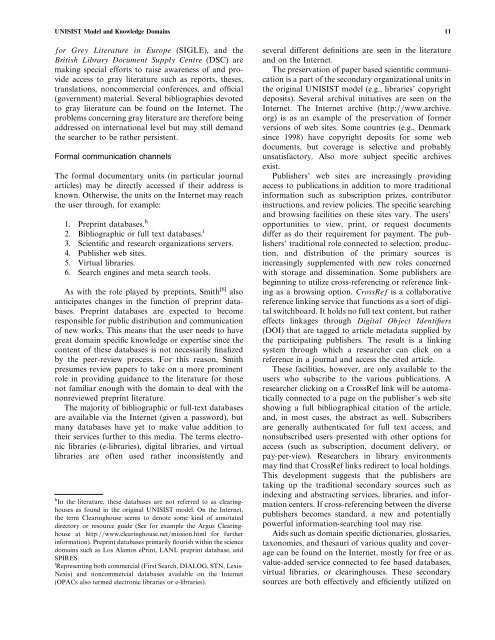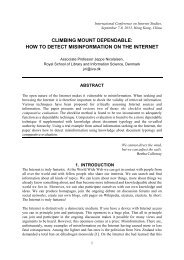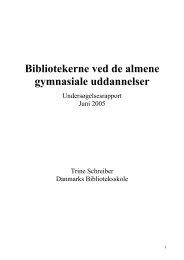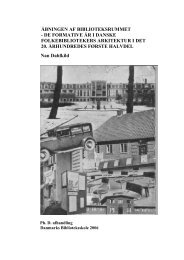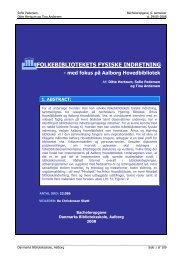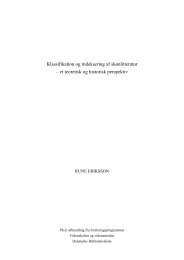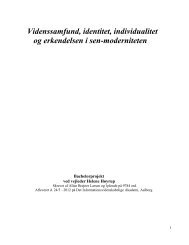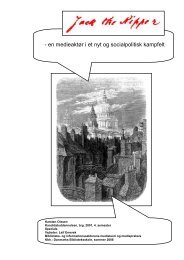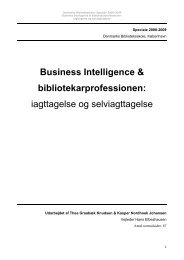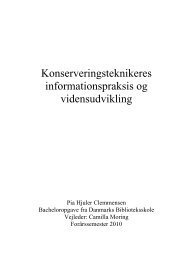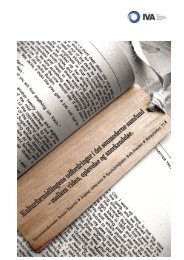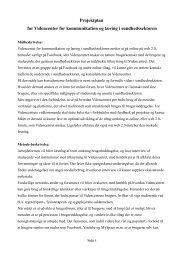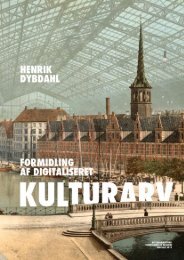UNISIST Model and Knowledge Domains
UNISIST Model and Knowledge Domains
UNISIST Model and Knowledge Domains
You also want an ePaper? Increase the reach of your titles
YUMPU automatically turns print PDFs into web optimized ePapers that Google loves.
<strong>UNISIST</strong> <strong>Model</strong> <strong>and</strong> <strong>Knowledge</strong> <strong>Domains</strong> 11<br />
for Grey Literature in Europe (SIGLE), <strong>and</strong> the<br />
British Library Document Supply Centre (DSC) are<br />
making special efforts to raise awareness of <strong>and</strong> provide<br />
access to gray literature such as reports, theses,<br />
translations, noncommercial conferences, <strong>and</strong> official<br />
(government) material. Several bibliographies devoted<br />
to gray literature can be found on the Internet. The<br />
problems concerning gray literature are therefore being<br />
addressed on international level but may still dem<strong>and</strong><br />
the searcher to be rather persistent.<br />
Formal communication channels<br />
The formal documentary units (in particular journal<br />
articles) may be directly accessed if their address is<br />
known. Otherwise, the units on the Internet may reach<br />
the user through, for example:<br />
1. Preprint databases. h<br />
2. Bibliographic or full text databases. i<br />
3. Scientific <strong>and</strong> research organizations servers.<br />
4. Publisher web sites.<br />
5. Virtual libraries.<br />
6. Search engines <strong>and</strong> meta search tools.<br />
As with the role played by preprints, Smith [6] also<br />
anticipates changes in the function of preprint databases.<br />
Preprint databases are expected to become<br />
responsible for public distribution <strong>and</strong> communication<br />
of new works. This means that the user needs to have<br />
great domain specific knowledge or expertise since the<br />
content of these databases is not necessarily finalized<br />
by the peer-review process. For this reason, Smith<br />
presumes review papers to take on a more prominent<br />
role in providing guidance to the literature for those<br />
not familiar enough with the domain to deal with the<br />
nonreviewed preprint literature.<br />
The majority of bibliographic or full-text databases<br />
are available via the Internet (given a password), but<br />
many databases have yet to make value addition to<br />
their services further to this media. The terms electronic<br />
libraries (e-libraries), digital libraries, <strong>and</strong> virtual<br />
libraries are often used rather inconsistently <strong>and</strong><br />
h In the literature, these databases are not referred to as clearinghouses<br />
as found in the original <strong>UNISIST</strong> model. On the Internet,<br />
the term Clearinghouse seems to denote some kind of annotated<br />
directory or resource guide (See for example the Argus Clearinghouse<br />
at http:==www.clearinghouse.net=mission.html for further<br />
information). Preprint databases primarily flourish within the science<br />
domains such as Los Alamos ePrint, LANL preprint database, <strong>and</strong><br />
SPIRES.<br />
i Representing both commercial (First Search, DIALOG, STN, Lexis-<br />
Nexis) <strong>and</strong> noncommercial databases available on the Internet<br />
(OPACs also termed electronic libraries or e-libraries).<br />
several different definitions are seen in the literature<br />
<strong>and</strong> on the Internet.<br />
The preservation of paper based scientific communication<br />
is a part of the secondary organizational units in<br />
the original <strong>UNISIST</strong> model (e.g., libraries’ copyright<br />
deposits). Several archival initiatives are seen on the<br />
Internet. The Internet archive (http:==www.archive.<br />
org) is as an example of the preservation of former<br />
versions of web sites. Some countries (e.g., Denmark<br />
since 1998) have copyright deposits for some web<br />
documents, but coverage is selective <strong>and</strong> probably<br />
unsatisfactory. Also more subject specific archives<br />
exist.<br />
Publishers’ web sites are increasingly providing<br />
access to publications in addition to more traditional<br />
information such as subscription prizes, contributor<br />
instructions, <strong>and</strong> review policies. The specific searching<br />
<strong>and</strong> browsing facilities on these sites vary. The users’<br />
opportunities to view, print, or request documents<br />
differ as do their requirement for payment. The publishers’<br />
traditional role connected to selection, production,<br />
<strong>and</strong> distribution of the primary sources is<br />
increasingly supplemented with new roles concerned<br />
with storage <strong>and</strong> dissemination. Some publishers are<br />
beginning to utilize cross-referencing or reference linking<br />
as a browsing option. CrossRef is a collaborative<br />
reference linking service that functions as a sort of digital<br />
switchboard. It holds no full text content, but rather<br />
effects linkages through Digital Object Identifiers<br />
(DOI) that are tagged to article metadata supplied by<br />
the participating publishers. The result is a linking<br />
system through which a researcher can click on a<br />
reference in a journal <strong>and</strong> access the cited article.<br />
These facilities, however, are only available to the<br />
users who subscribe to the various publications. A<br />
researcher clicking on a CrossRef link will be automatically<br />
connected to a page on the publisher’s web site<br />
showing a full bibliographical citation of the article,<br />
<strong>and</strong>, in most cases, the abstract as well. Subscribers<br />
are generally authenticated for full text access, <strong>and</strong><br />
nonsubscribed users presented with other options for<br />
access (such as subscription, document delivery, or<br />
pay-per-view). Researchers in library environments<br />
may find that CrossRef links redirect to local holdings.<br />
This development suggests that the publishers are<br />
taking up the traditional secondary sources such as<br />
indexing <strong>and</strong> abstracting services, libraries, <strong>and</strong> information<br />
centers. If cross-referencing between the diverse<br />
publishers becomes st<strong>and</strong>ard, a new <strong>and</strong> potentially<br />
powerful information-searching tool may rise.<br />
Aids such as domain specific dictionaries, glossaries,<br />
taxonomies, <strong>and</strong> thesauri of various quality <strong>and</strong> coverage<br />
can be found on the Internet, mostly for free or as<br />
value-added service connected to fee based databases,<br />
virtual libraries, or clearinghouses. These secondary<br />
sources are both effectively <strong>and</strong> efficiently utilized on


